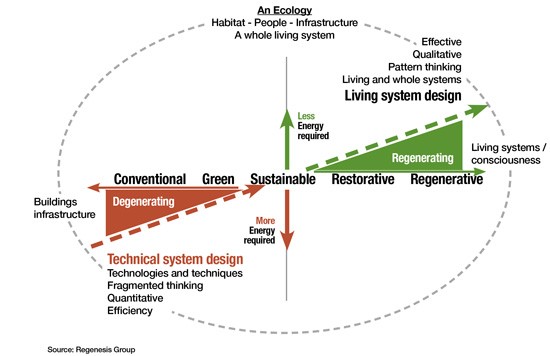Recently, the University of Oslo adopted its own Sustainability Strategy. Lots of nice words, but as always, there is tension between what is said and what is done. Real change is needed if we want to tackle the climate emergency and the attack on biodiversity. We often look at design to be that changemaker. Since the 1970s, the terms sustainable design and green design have been used to refer to design that makes a difference. We are now in 2023 and we are still surrounded by unsustainable design. We therefore would like our master students to go a step further and investigate the field of regenerative design.
Regenerative design pursues a holistic worldview in which humans and nature work together to create a livable place/community for all. When you design, you need to take the whole system in consideration. That means that in a regenerative design process, a river or a tree or an ecosystem can be a co-designer or participant. This changes the way how we think about design. If this is something that triggers your interest, and you have an idea for a topic, contact us.
If you want to read more about regenerative design and regenerative sustainability, see the literature below.
Supervision
We regard the social aspect of doing a master's thesis as important as the academic aspect. As supervisors, we will offer you an engaged and inspiring environment in the Sustainability Lab as well as access to experts when needed.
Recommended courses:
- IN5010 Design, Technology & Society
- IN5470 Design for Sustainability (new course code in 2024)
- You may also want to choose one of the following courses: IN5120 (Tangible Interaction), IN5530 (Research through Design) or IN5510 (Participatory Experimental Design)
-
A SUM course is also an option:
SUM4019 – Consumption, Sustainability and Social Change , (spring, 10 credits)
SUM4034 – Debates in Post-development & Degrowth , (spring, 10 credits)
SUM4501 – Achieving the SDGs: Global Goals and National Interests , (spring, 5 credits)
SUM4502 – INCLUDE – Socially Inclusive Energy Transition , (every other spring, 5 credits)
References and inspiring literature:
Design projects
Blurring the lines between humans and nature - Umeå Institute of Design
Advocate: (re)shaping the smart home with a river as the primary stakeholder - Lukas Flynn
Articles
Ceschin, F., & Gaziulusoy, İ. (2019). Design for Sustainability: A Multi-level Framework from Products to Socio-technical Systems. Routledge. https://doi.org/10.4324/9780429456510 (book used in Design for Sustainability course)
Gibbons, L. V. (2020). Regenerative—The New Sustainable? Sustainability, 12(13), 5483. https://doi.org/10.3390/su12135483
Jankel, N. S. (2021). Regenerative Tech: Slow Down & Mend Things. Switch On. https://medium.com/switch-on/regenerative-tech-slow-down-mend-things-fdfc04eb6cc7
Mang, P., & Reed, B. (2012). Regenerative Development and Design. In R. A. Meyers (Ed.), Encyclopedia of Sustainability Science and Technology (pp. 8855–8879). Springer. https://doi.org/10.1007/978-1-4419-0851-3_303
Reed, B. (2007). Shifting from ‘sustainability’ to regeneration. Building Research & Information, 35(6), 674–680. https://doi.org/10.1080/09613210701475753
Space 10. (2021). Regenerative by Design. https://space10.com/regenerative-by-design/
Wikipedia (2022). Regenerative design. https://en.wikipedia.org/wiki/Regenerative_design

